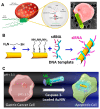Biorobotic Drug Delivery for Biomedical Applications
- PMID: 39125066
- PMCID: PMC11314275
- DOI: 10.3390/molecules29153663
Biorobotic Drug Delivery for Biomedical Applications
Abstract
Despite extensive efforts, current drug-delivery systems face biological barriers and difficulties in bench-to-clinical use. Biomedical robotic systems have emerged as a new strategy for drug delivery because of their innovative diminutive engines. These motors enable the biorobots to move independently rather than relying on body fluids. The main components of biorobots are engines controlled by external stimuli, chemical reactions, and biological responses. Many biorobot designs are inspired by blood cells or microorganisms that possess innate swimming abilities and can incorporate living materials into their structures. This review explores the mechanisms of biorobot locomotion, achievements in robotic drug delivery, obstacles, and the perspectives of translational research.
Keywords: biological engine; biorobot; drug-delivery systems; locomotion.
Conflict of interest statement
The authors declare no conflicts of interest.
Figures




References
-
- Shim N., Cho H., Jeon S.I., Kim K. Recent developments in chemodrug-loaded nanomedicines and their application in combination cancer immunotherapy. J. Pharm. Investig. 2024;54:13–36. doi: 10.1007/s40005-023-00646-7. - DOI
-
- Lee J., Lee W.T., Le X.T., Youn Y.S. Cancer cell membrane-decorated hybrid liposomes for treating metastatic breast cancer based on enhanced cancer immunotherapy. J. Pharm. Investig. 2024;54:453–465. doi: 10.1007/s40005-023-00661-8. - DOI
-
- Cho H.-J. Recent progresses in the development of hyaluronic acid-based nanosystems for tumor-targeted drug delivery and cancer imaging. J. Pharm. Investig. 2019;50:115–129. doi: 10.1007/s40005-019-00448-w. - DOI
-
- Al-Azzawi S., Masheta D. Designing a drug delivery system for improved tumor treatment and targeting by functionalization of a cell-penetrating peptide. J. Pharm. Investig. 2019;49:643–654. doi: 10.1007/s40005-018-00424-w. - DOI
Publication types
MeSH terms
Grants and funding
LinkOut - more resources
Full Text Sources

